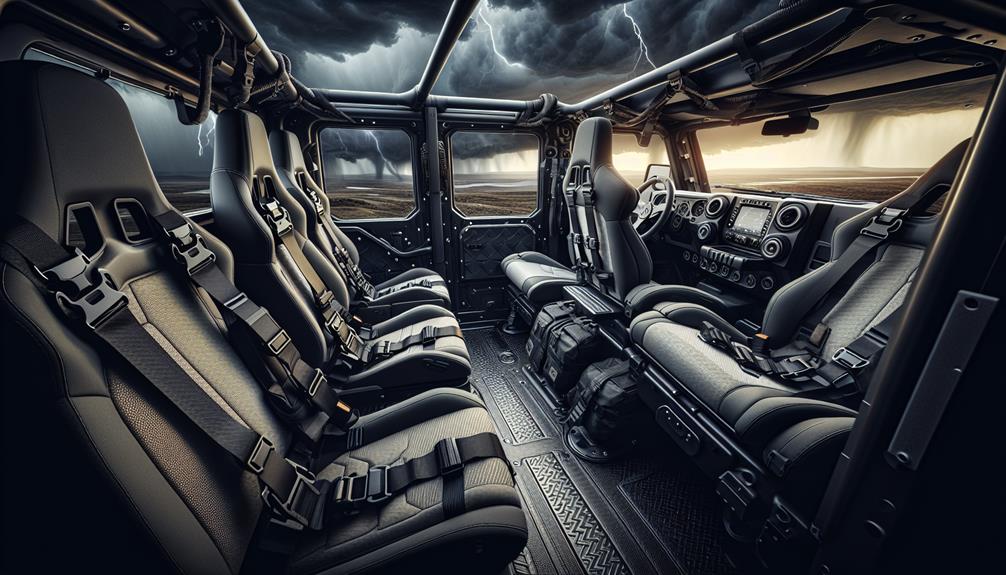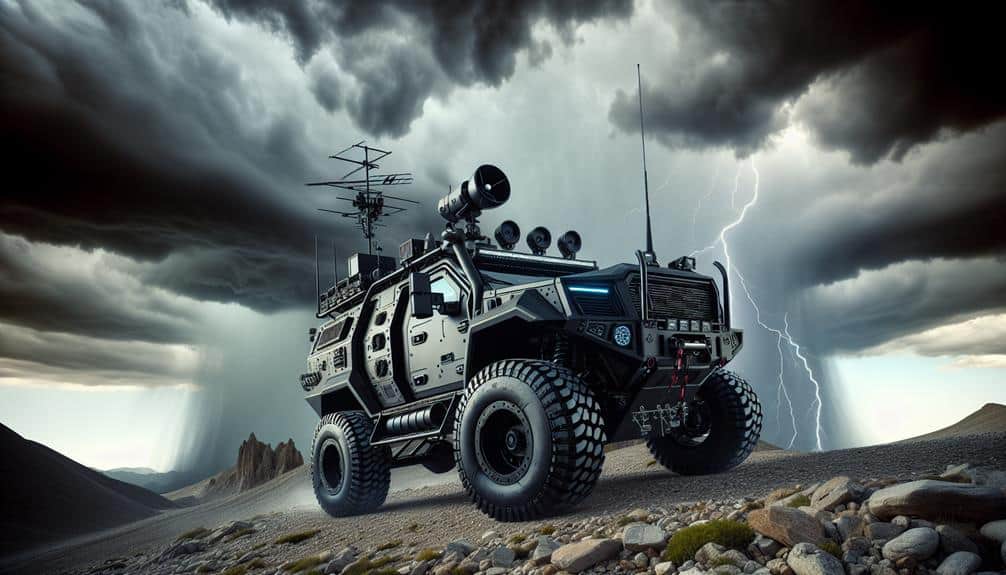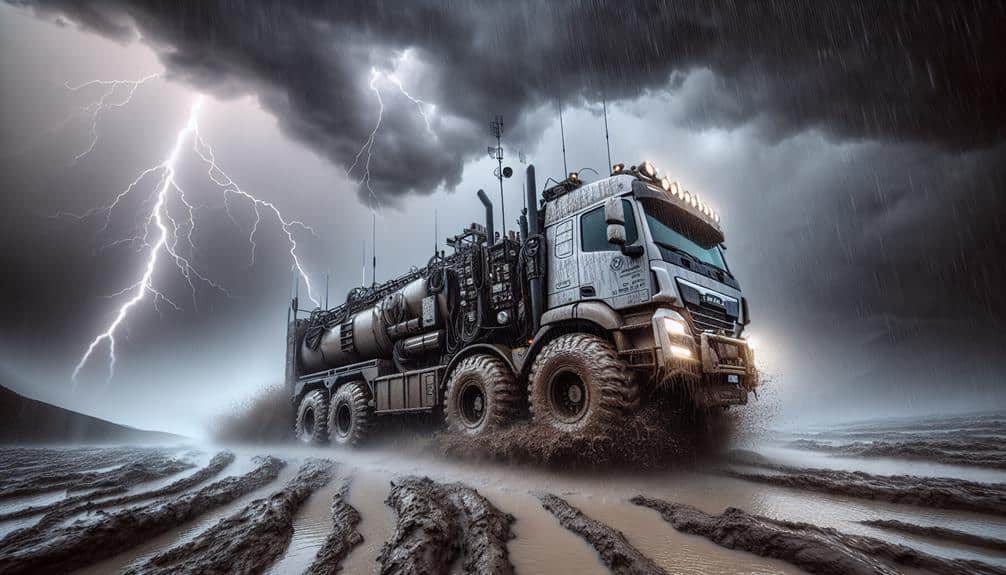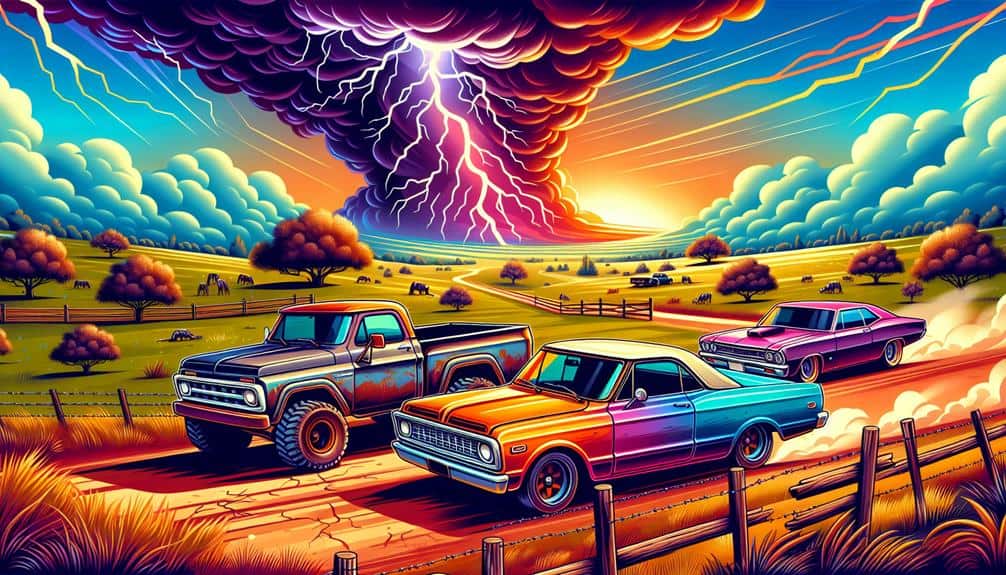We maximize seating capacity in storm chasing SUVs by selecting models with flexible, modular seating configurations and ample cargo space. We incorporate fold-flat rear seats to adapt quickly between passenger and equipment needs. Strengthening the SUV's frame and using impact-resistant materials guarantees safety. Swivel seats and under-seat storage enhance functionality, making it easy to adapt to various mission requirements. A critical element is balancing comfort with capacity, offering adjustable headrests and industry-standard safety measures. Efficient interior layouts prioritize both comfort and emergency preparedness. This approach ensures peak performance and safety, providing detailed strategies to enhance your storm chasing experience.
Key Points
- Opt for SUVs with modular and adjustable seating to accommodate varying crew sizes and equipment needs.
- Choose models with fold-flat rear seats to maximize cargo space when necessary.
- Implement under-seat storage systems to keep essential gear organized and cabin space optimized.
- Ensure seating configurations include safety features like reinforced frames, seat belts, and impact-resistant windows.
Choosing the Right SUV
Selecting the best SUV for storm chasing involves evaluating key factors like seating capacity, durability, and off-road capabilities. First, we need to take into account seating flexibility and size considerations. An SUV that offers adjustable seating configurations will allow us to accommodate more passengers or gear as needed. Models like the Chevrolet Suburban or Ford Expedition excel in this area, providing ample space and versatile seating options.
Storage solutions are equally vital. We need an SUV with sufficient cargo space to store essential equipment like weather instruments, safety gear, and personal items. Vehicles with fold-flat rear seats and multiple compartments can enhance our storage capabilities. For example, the Toyota 4Runner features a sliding rear cargo deck, making it easier to load and unload heavy items.
Passenger comfort shouldn't be underestimated. Long hours on the road require seats that provide adequate support and cushioning. Opt for models with ergonomic designs and climate control systems to ensure a comfortable ride for everyone on board. The Jeep Grand Cherokee offers heated and ventilated seats, contributing to passenger well-being during extensive chases.
Custom Seating Solutions
Custom seating solutions can greatly improve the functionality and comfort of our storm chasing SUV by allowing us to tailor the interior layout to meet specific needs. By optimizing seat configurations and space-saving options, we can make sure that every inch of the vehicle is used efficiently.
Let's explore some custom solutions that can make a significant difference:
- Modular Seat Configurations: These allow us to adjust the seating arrangement based on crew size and equipment needs. By incorporating tracks and quick-release mechanisms, we can easily add or remove seats, transforming our SUV from a passenger carrier to an equipment hauler in minutes.
- Under-Seat Storage Systems: Installing under-seat storage compartments maximizes otherwise wasted space. These compartments can store essential gear, providing quick access without sacrificing seating capacity. This solution keeps the cabin organized and clutter-free, essential during high-pressure storm chasing missions.
- Swivel Seats: By integrating swivel seats in the second row, we can create a mobile command center. These seats can rotate to face the rear, facilitating team discussions and data analysis on the go. This flexibility enhances communication and coordination, key elements for successful storm chasing.
Utilizing Foldable Seats
Incorporating foldable seats into our storm chasing SUV allows us to dynamically adjust the interior space to accommodate both crew members and equipment efficiently. By utilizing space saving options, we can make sure that every inch of the vehicle is optimized.
Foldable seats provide a creative solution, allowing us to quickly reconfigure the layout based on our immediate needs. For example, when we need to transport additional gear or scientific instruments, the seats can be folded flat, creating a spacious cargo area.
The flexibility of foldable seats guarantees that passenger comfort is never compromised. Each seat can be individually adjusted to match the specific requirements of our crew, whether it's for long drives or quick changes between storm sites. High-quality materials and ergonomic designs are essential to maintain comfort and durability, especially during extended periods of use.
Moreover, the locking mechanisms and adjustable headrests contribute to both safety and passenger comfort. We prioritize ease of use, making sure that seat adjustments require minimal effort and time.
This adaptability not only enhances our operational efficiency but also provides the freedom to tailor the interior space to our evolving needs.
Optimizing Interior Layout
By focusing on optimizing the interior layout, we can strategically arrange equipment and seating to maximize both functionality and space efficiency in our storm chasing SUVs. We need a methodical approach to guarantee every inch of space serves a purpose, and our seating configuration supports both the team and the gear.
First, let's prioritize our seating configuration:
- Modular Seating: Utilize adaptable seats that can be reconfigured based on the number of occupants and equipment needs. For instance, using L-track systems allows quick adjustments, making it easy to switch between passenger and cargo modes.
- Underseat Storage: Implement underseat storage solutions to stow essential gear without sacrificing legroom or accessibility. This concealed storage enhances space efficiency by utilizing otherwise wasted space.
- Fold-Flat Seats: Ensure that all passenger seats can fold flat to create a seamless cargo area when needed. This design enables us to prioritize either passenger comfort or equipment storage based on current needs.
Safety Considerations

Ensuring the safety of our team and equipment during storm chasing requires meticulous attention to both structural integrity and emergency preparedness. We must first prioritize safety precautions by reinforcing the SUV's frame to withstand high winds and debris. Utilizing roll cages and impact-resistant windows is vital. Each seat must be equipped with seat belts that meet or exceed industry standards, guaranteeing every team member is securely fastened.
Airbags, both front and side, are non-negotiable for enhanced protection. Their deployment can be life-saving in the event of a collision or rollover. We also need to install strategically placed emergency exits—preferably on both sides of the vehicle—to facilitate rapid evacuation. These exits should be clearly marked and accessible, even if the vehicle is compromised.
Furthermore, we'll incorporate a robust communication system to maintain contact with external support and emergency services. Fire extinguishers and first-aid kits must be easily reachable from multiple points within the SUV.
Balancing Comfort and Capacity
To effectively balance comfort and capacity in our storm-chasing SUVs, we need to optimize the interior layout to accommodate maximum seating without compromising on essential ergonomic and safety features. Our goal is to guarantee comfort enhancements and strategic seating arrangements while adhering to capacity limitations dictated by storm equipment.
First, we should consider the configuration of seats. By utilizing modular seating, we can rearrange or remove seats as needed, allowing for flexible uses depending on crew size and equipment load.
Second, the integration of ergonomic seats is pivotal. These should be designed to reduce fatigue during long hours of storm chasing. High-density foam and lumbar support can make a significant difference.
Third, we need to allocate space efficiently for storm equipment. This means incorporating built-in storage solutions such as under-seat compartments and overhead bins, ensuring that all essential gear is readily accessible without encroaching on passenger space.
Here's a breakdown:
1. Modular Seating:
Adjustable configurations to adapt to various crew sizes and equipment needs.
2. Ergonomic Seats:
High-density foam and lumbar support to reduce fatigue.
3. Built-in Storage:
Under-seat compartments and overhead bins for storm equipment.
Frequently Asked Questions
What Are the Legal Requirements for Seating Modifications in Storm Chasing Vehicles?
We need to understand regulations and guarantee compliance when modifying seating. Safety standards require proper installation techniques and materials. It's vital we follow detailed specifications to guarantee passenger safety and meet all legal requirements.
How Do Storm Chasing Teams Handle Emergency Evacuations With a Full Suv?
Emergency procedures may appear challenging, but we've got it covered. Our seating arrangements guarantee swift exits. Each team member has a clear path, and we've rehearsed evacuations thoroughly to uphold safety and efficiency.
Are There Any Insurance Implications for Modifying SUV Seating Capacity?
We need to take into account insurance implications and safety concerns. Modifying SUV seating capacity can void warranties, affect coverage, and increase premiums. Safety standards might not be met, potentially endangering occupants and impacting insurance claims.
What Are the Best Practices for Maintaining Modified Seating in Storm Chasing Suvs?
We prioritize safety precautions and seating comfort by ensuring all seating modifications comply with regulations. Regularly inspect and secure modifications, maintaining weather readiness for storm chasing. This guarantees both safety and comfort, allowing us to chase storms freely.
How Do You Ensure All Equipment Fits With the Additional Seating?
We weave a tapestry of efficiency by prioritizing equipment organization and seating comfort. We measure, document, and allocate space meticulously, ensuring all gear fits snugly without compromising anyone's freedom or comfort during our high-adrenaline storm pursuits.


